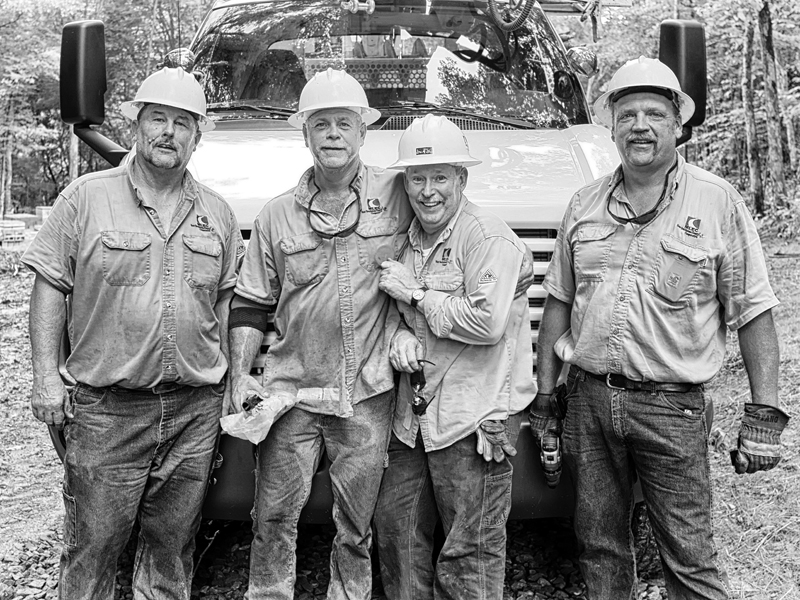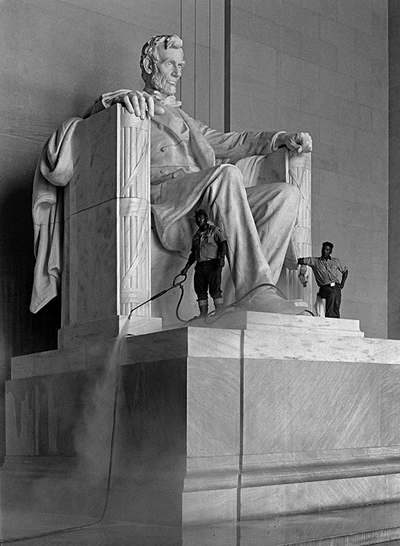I've been having an ongoing discussion with the Anonymous Celebrity Judge of the recent "People Working" contest (who is real; this isn't one of my jokey misdirections). We have a number of general, one might say generic, observations. In no particular order:
• First, it's a rich subject with many interpretations. Two I mentioned to him as being very different were a landscape with a semi truck barely visible at the extreme edge of the frame, and a photo of a very small girl "helping" to paint a wall in her parents' house and taking her task very seriously. Those are two extremely different vectors into the theme. Contrast that with an Asian fisherwoman, and a man surrounded by machines in a hat factory.
• Action photos—pictures of people actually doing something—generally worked better than static photos. Although, once they cross the higher bar, some of the static photos are wonderful. One portrait of a number of jovial-looking hard-hatted workers lined up for a group portrait in front of a truck is definitely going to make the semifinals. Not an action shot, but still a good 'un.
 "Linemen are the 'salt of the Earth.' Dedicated, hard workin', and reliable, with a little mischief thrown in to keep things interestin'." Photo by Carl Wilson, Clarksville, Tennessee.
"Linemen are the 'salt of the Earth.' Dedicated, hard workin', and reliable, with a little mischief thrown in to keep things interestin'." Photo by Carl Wilson, Clarksville, Tennessee.
• A number of people were forced by our imposed theme to fudge a bit—that is, they really had no pictures directly on the theme, so they pressed into service a picture that really belongs in a different category (like "Sea World" or "Street Performer." Yes, it's possible those people are indeed "working," but...).
Of course that's half the fun—what really conveys the idea of the theme in a tangential way, and which attempts at a "stretched" interpretation don't quite work? A closeup of a guy playing a guitar that has dramatic color might indeed be a beautiful shot, but what about the picture implies that he's working? He could just be a guy playing his guitar. So what I'm saying is, some shots express the theme on a technicality, you might say; but, looked at from the other direction—from the vantage point of a viewer coming cold to the picture—the idea of "here's a guy working" would never be the first thing that comes to mind.
• A number of pictures are grab shots. We're gonna have to talk about this. I have a lot to say on that subject. But maybe that's best left to later.
• The judge notes that big machines tended to be rendered in black-and-white and that smoke and fire seems to be a handy way to get drama into a shot.
• Exotic locations (non-first-world, more remote, accessible to fewer people) both collectively added richness to the entries as a whole and also served as a crutch in some cases. A not-so-good shot isn't necessarily saved because it was taken in Antarctica. (We got no entries of pictures taken in Antarctica that I'm aware of. I'm trying not to point out anything negative about any specific person's picture. If I missed one, and your picture was actually taken in Antarctica, I'm not talking about you.)
Themes in your head
One of the points of the theme (which I came up with—you need something with a contest, to keep the entries from just being a hodgepodge) was to demonstrate how much richness there is in a simple idea like this. Having a few themes that you think of as "yours," and that you keep coming back to—that you keep looking for in a variety of life situations, or deliberately seek out—can help your thinking and help direct your photographing in useful ways. And save you from being a random hobby photographer who just takes random standard clichés of everything. (We all need saving from that, to some extent.)
Part of that problem is deciding—consciously. The other part is noticing. That is, noticing what you're drawn to, what you like photographing and what you do well with. For instance, I suck in cities. I just don't do well on city streets. On the other hand, I love the water's edge—lakes, oceans, swimmers, boats. So that's one of the "themes" in the back of my mind that I think of as "mine." Some people like doors. Some, stores. Others, hairdos. The young Lartigue liked motion—moving things. Sure enough, a great many of his pictures feature motion of some sort. Where would the Sartorialist be without his surpassing interest in fashion on the hoof? Any photographer who is past the beginner level should have some of these ideas about what subject areas they gravitate toward. (It also helps in that it potentially lets you off the hook and allows you to ignore certain "photo opportunities." For instance, I never took photos of sunsets, because I was a B&W photographer. Of course, now that I'm stuck with cameras that record colors, I'm forced unhappily into taking sunset pictures. I wish I could ignore 'em. But the camera records colors. What can I do? It's not my fault.)
But enough of that for now. We're going to put the selects from the contest up in several batches, and hopefully we'll have the first batch done soon. (Da Judge is picking all the finalists; I get to award the prizes.) I'm looking forward to seeing how they look together.
Thanks again to all the participants, and to our hard-working judge.
Mike
Original contents copyright 2013 by Michael C. Johnston and/or the bylined author. All Rights Reserved. Links in this post may be to our affiliates; sales through affiliate links may benefit this site.
(To see all the comments, click on the "Comments" link below.)
Featured Comments from:
David Dyer-Bennet (partial comment): "Yeah, I ended up not submitting, because the theme is pretty much not one I've worked on. Plus all the pictures I thought about submitting, I was unsure how well they really fit, or whether they qualified. [...] My Lincoln Memorial photo that Ctein used in his Perseverance column is arguably a 'work' photo—but has been previously published, here, so that wasn't an option."
Mike replies: Yeah, but it's a great shot, and a perfect picture for the theme, so it's worth "repeating" so to speak, don't you think?
Oskar Ojala (partial comment): "...The problem with being an amateur/hobbyist/whatever is the sheer boundlessness of the whole thing; one can play around with different types of photography, effects, styles, subjects, equipment etc. more or less freely, which is both a blessing and a curse. Having a theme brings a certain focus...."



